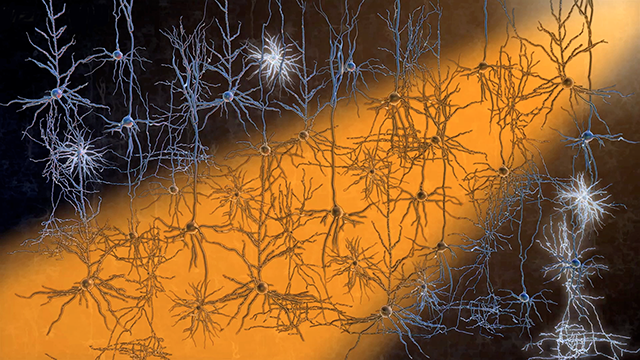|
|
Repairing neurons with light
The nervous system is built to last the lifetime of an animal. But disease and trauma can overpower neurons to fail in maintaining function or even self repair. However, a team of German scientists have succeeded in stimulating an injured neural circuit in zebrafish to repair itself — using light waves.
Optogenetics is a cutting-edge technology combining elements of Optics with Genetics. Scientists have identified proteins sensitive to specific wavelengths of light which they can use to target genes in cells. The genes can then be manipulated to change phenotype, or the specific traits characteristic to that species, depending on the intensity and/or amount of light exposure.
Key to this experiment is the messenger molecule cAMP produced by an enzyme called adenyly cyclase. Scientists at the Research Unit Sensory Biology and Organogenesis in München, Germany, inserted a form of adenyly cyclase enzyme responsive to blue light into zebrafish larvae. With that enzyme in place, scientists were then able to modify the production of cAMP in cells with those genes, by specifically shining blue light on them.
The resulting work is published in the journal Cell, Current Biology.
Zebrafish are particularly suited for optogenetic approaches as their skin is transparent. Light can penetrate their skin and reach targeted cells easily, explains team leader Dr. Hernán López-Schier, head of the Research Unit Sensory Biology and Organogenesis at Helmholtz Zentrum in München, Germany.
Researchers used this system on zebrafish larvae, severing the sensory lateralis nerves of the larvae which normally communicate sensory signals to the brain. In previous experiments, when pharmacological or genetic approaches were used to increase levels of cAMP with the intention of initiating nerve repair, insufficient healing ocurred. Timing is critical in precise neural-circuit reconstruction and cannot be managed easily on molecular targets
"When blue light was shone on severed nerves that expressed a photo-activated adenylyl cyclase, their repair was dramatically increased.
"While untreated nerve terminals only remade synapses in five percent of the cases, about 30% were able to after photostimulation [elevating cAMP with blue light]."
Yan Xiao PhD candidate and first author of the study.
At the German Research Center for Environmental Health, scientists focus their work on developing personalized medical approaches for the prevention and therapy of major common diseases such as diabetes mellitus. The independent Sensory Biology and Organogenesis (SBO) research unit works with zebra fish as a model system to examine and understand cell and molecular reactions that control sensory system development. Their goal is understanding the evolution of sensory organs and how regeneration happens.
"Optogenetics have revolutionized neurobiology, since the method has already been used to modify the electrical activity of neurons.
"However, our results show for the first time that the repair of a complex neural circuit in a whole animal can be promoted remotely by the use of light."
Hernán López-Schier PhD, head of the Research Unit.
Dr. López-Schier believes this is only the beginning: "Our results are a first step. Now we would like to investigate, whether these results can be extrapolated beyond single neurons in zebrafish, to more complex neuronal circuits of higher animals."
The scientists feel this method could be used for future therapeutic approaches in the treatment of neuropathies like those occurring from Diabetes and other diseases.
Abstract
Environmental insult, disease or trauma can affect the physical integrity of neuronal circuits, and the inability of many neurons to regenerate injured axons invariably leads to irreversible neural dysfunction. The conserved second messenger cyclic adenosine monophosphate (cAMP) can promote axonal re-growth . Widely used pharmacological or genetic approaches to increase intracellular levels of cAMP are often inadequate for precise neural-circuit reconstruction because their activity cannot be easily timed to specific target cells. These shortcomings have prevented the controlled repair of pre-defined neurons at selected time points in whole specimens. Thus, technologies to guide neuronal repair in time and space would enable studies of neural-circuit recovery with unprecedented resolution. Towards this aim, we have implemented a proof-of-principle optogenetic method to promote the selective regeneration of refractory axons in a living vertebrate.
Original publication: Xiao, Y. et al. (2015). Optogenetic stimulation of neuronal repair, Current Biology, DOI: 10.1016/j.cub.2015.09.038
Reference material:
How The Brain Keeps Time McGovern Institute for brain research MIT
Selective Photostimulation of Genetically ChARGed Neurons Laboratory of Neural Systems, Cellular Biochemistry and Biophysics Program, Memorial Sloan-Kettering Cancer Center, 1275 York Avenue, New York, NY 10021 USA
Millisecond-timescale, genetically targeted optical control of neural activity Department of Bioengineering, Stanford University, Stanford, California, USA; Max-Planck-Institute of Biophysics, Department of Biophysical Chemistry, Frankfurt am Main, Germany; Department of Biochemistry, Chemistry and Pharmaceutics, University of Frankfurt,Frankfurt am Main, Germany; Department of Psychiatry and Behavioral Sciences, Stanford School of Medicine, Stanford, California, USA; University of Würzburg, Würzburg, Germany
Return to top of page
|
|
|
Nov 19, 2015 Fetal Timeline Maternal Timeline News News Archive

Optogenetics is a technique that allows researchers to control brain cell activity using light.
Image Credit:
MIT McGovern Institute
|
|
| |
|



